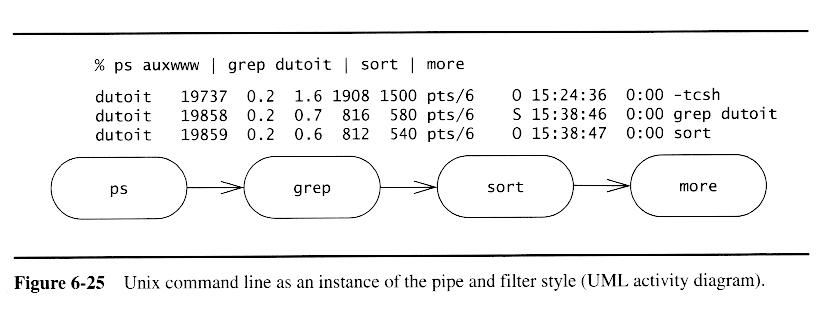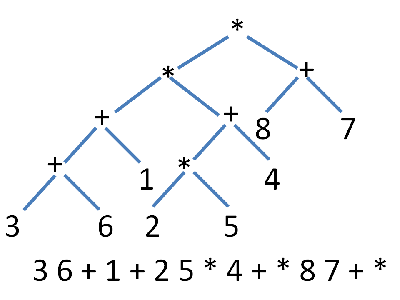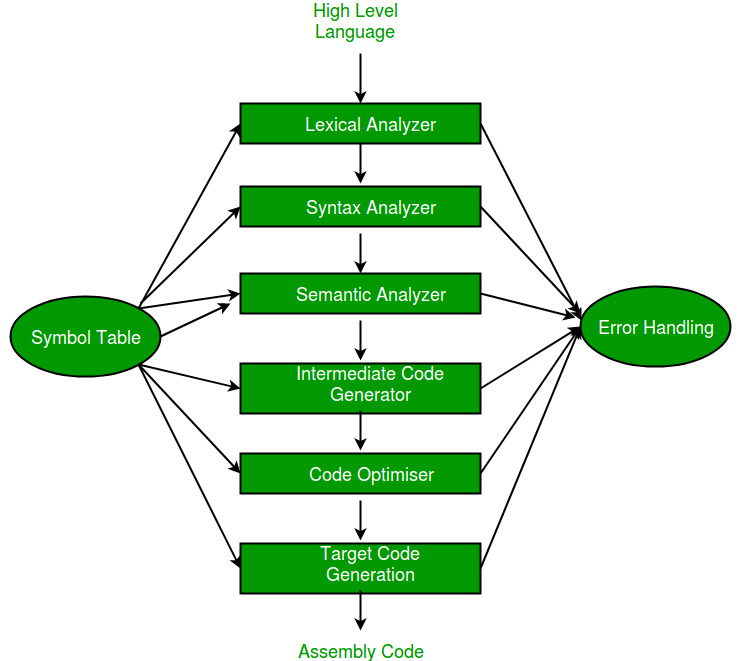
home |
syllabus |
src |
submit |
chat |
©2019
by Tim Menzies
- shebang
- syntax
- semantics
-
Intent Divide and conqueor
-
Probems: Need to apply a series of ordered but independent computations is required, perhaps as a series of time-step operations, on ordered data.
-
Structure: Pipes (that move things) and filters (that change things).
-
Example: Bell Labs. 1970s. Hundreds of Ph.D. comptuer scientists with no job descriptions all looking for ways to work together (this is the world that gave us UNIX). They broke all their work up into tiny tools (filters) which could be wired together in many and magical magnficent ways.
-
Rules of thumb:
- K.I.S.S. Unix piles are (mostly) one input, one output (i.e. "|" not "Y" or "T"); makes then simple to use
- Use a common format for all i/o (e.g text files, comma-seperated-values, json)
- Each filter should do one thing well and one thing only.
- Useful for multi-tasking (operating system can run each filter seperately).
- Don't use when 2 filters need to tightly co-ordinate with each other
- Don't use when very complex state has to be transferred between the filters
- Can be slower to run than "one big pile of code" since so much i/o between filters
- Can be easier to maintain than "one big pile of code" since easier to upgrade each bit in isolation
- Don't use for GUI applications where users want to hunt and peck all over different parts of the pipe (since pipes are fast methods for going here to there).
Pre-processor for interpreter.
Core cocentps:
- parse tree
- operator
- operand
- predence
- predence clash
- associativity
- xfx, fx, xf
- yfx, xfy, fy, yf
- prefix, index, postfix
- Intent Seperate what you want to say from underlying
execution device
- You want some platfrom independent way to express solutions.
- Or you want to think one way (e.g. pattern matching, lambda bodies, compartmental models, agents, objects, classes, messages) and the underlying machine does not support that (e.g. it only knows about stacks and registers).
- Or you want to batch up many of the underlying services into some convenient, more succinct, summary language
- Problem
-
How can a grammar for a simple language be defined so that sentences in the language can be interpreted?
-
Examples
-
Homework 1a
-
any interpretered language (Python, Runy, Prolog...)
-
- Stucture
- Grammaer
- Terminal (has 0 rewrites)
- Non-terminals (has N rewrites)
- Abstract syntax tree (AST) : which part of the grammer is needed to describe a particular set of sentences.
- Names
- Interpreter
- Abstract machine
- Discussion
- Interpreters are one of the most stunning successes of computer science. Fast, easy to understand, cross platform tools enabled the open source revolution and, in directly, the move to cloud compute (you can't shuffle things round cloud CPU farms unless everything runs the same on all platforms).
- Studying interepreters, and more importantly, writing your own, is the best way to understand a a langguage.
- Rules of Thumb
- Intepret into a virtual machine, then build an execution tool for the virtual machine (e.g. Java ==> JVM)
- e.g. Smalltalk ==> bytecodes,
- e.g. JAVA ==? JVM
- e.g. Lisp ==> lambda bodies - Useful for cross platfrom stuff
- To build a compiler, interpret into machine code then cache that intepretation
- So the next time you want to do something, no wait for the interpreter
- Seperate out lexical analyzer (strings to tokens) from syntactical analyzer (tokens to parse trees) from semantic analyzer (how to run the trees) from optimizer from target code generation
- Simple, uniform semantics makes interpretation easier
- Added layers of interpretation slows down the program
- So yes, JAVA is slower than C
- CPUs are faster these days so why not interpret?
- For many applciations, network latency is what drives runtime speed so adding an interepred language doesn't slow down anything very much.
- Maintainability and usability can be more important than mere speed
- Sometimes, the clarity of the higher level interpreted system can make it optimize better
- Intepret into a virtual machine, then build an execution tool for the virtual machine (e.g. Java ==> JVM)
- See also
- Macros
- Lambda calculus (where "computation" means rewriting sub-trees)
- Unification (where "computation" means
matching sub0trees) - Composite pattern provides a way to represent a part-whole hierarchy as a tree (composite) object structure.
- Builder pattern provides a way to create the elements of an object structure. Iterator pattern provides a way to traverse the elements of an object structure.
- Visitor pattern provides a way to define new operations for the elements of an object structure.
- Interpreter pattern represents a sentence in a simple language as a tree (composite) object structure (abstract syntax tree).



